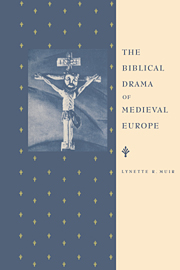Book contents
- Frontmatter
- Contents
- List of illustrations
- Preface
- Acknowledgements
- List of abbreviations
- Map 1 Medieval Europe showing locations of principal play-texts and records cited in this study
- Map 2 Enlargement of central area showing locations of liturgical and feast-day plays as defined in chapter 1
- Map 3 Enlargement of central area showing locations of civic and community plays as defined in chapter 2
- Introduction: Christian Europe and the Play of God
- PART ONE THE THEATRICAL COMMUNITY
- 1 Liturgical and feast-day drama
- 2 Civic and community drama
- 3 Performance and the community
- PART TWO THE THEATRICAL TEXT
- Conclusion: survival and revival
- Appendix: the liturgical context of the plays
- Notes
- Bibliographical index of plays
- Performance records and references
- General bibliography
- Index
3 - Performance and the community
Published online by Cambridge University Press: 18 September 2009
- Frontmatter
- Contents
- List of illustrations
- Preface
- Acknowledgements
- List of abbreviations
- Map 1 Medieval Europe showing locations of principal play-texts and records cited in this study
- Map 2 Enlargement of central area showing locations of liturgical and feast-day plays as defined in chapter 1
- Map 3 Enlargement of central area showing locations of civic and community plays as defined in chapter 2
- Introduction: Christian Europe and the Play of God
- PART ONE THE THEATRICAL COMMUNITY
- 1 Liturgical and feast-day drama
- 2 Civic and community drama
- 3 Performance and the community
- PART TWO THE THEATRICAL TEXT
- Conclusion: survival and revival
- Appendix: the liturgical context of the plays
- Notes
- Bibliographical index of plays
- Performance records and references
- General bibliography
- Index
Summary
RECORDS OF PERFORMANCE
Information about the performance of biblical plays comes from two principal sources: the texts themselves which often include stage directions and instructions for the decor, and the records of churches, towns and community groups. Other sources include letters, contemporary or eye-witness descriptions, and decrees, both civic and canonical.
As the two previous chapters have indicated, these records offer a picture of flourishing and varied dramatic activity in towns and villages all over Europe. Religious subjects make up the greater part of the surviving repertory and dominate the records. They were performed in churches and palaces, streets, squares and graveyards. They might be staged in a single (often indoor) location; in a processional or stational mode; or on a multiple, fixed-location set. The organisation of these different types of play varied from country to country and from group to group, but in all cases a high proportion of the information comes from the financial records of town or court, confraternity, guild or church. For although most medieval drama was technically amateur, costumes, properties and often, though not always, scaffolds (the commonest medieval term for a raised stage) had to be provided for even the simplest plays.
Since it is impossible to consider this huge subject in detail, this chapter will be concerned mainly with three aspects related to the performing community: the interrelationship of audience and actors in the different kinds of staging; the financial organisation of the plays; and the place of women in the theatrical community.
- Type
- Chapter
- Information
- The Biblical Drama of Medieval Europe , pp. 45 - 62Publisher: Cambridge University PressPrint publication year: 1995



